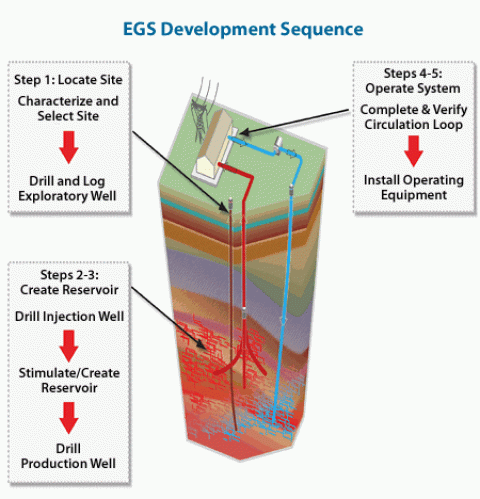Geothermal Energy and the Enhanced Geothermal Systems Concept
Heat is naturally present everywhere in the earth. For all intents and purposes, heat from the earth is inexhaustible. Water is not nearly as ubiquitous in the earth as heat. Most aqueous fluids are derived from surface waters that have percolated into the earth along permeable pathways such as faults. Permeability is a measure of the ease of fluid flow through rock. The permeability of rock results from pores, fractures, joints, faults, and other openings which allow fluids to move. High permeability implies that fluids can flow rapidly through the rock. Permeability and, subsequently, the amount of fluids tend to decrease with depth as openings in the rocks compress from the weight of the overburden.
At shallow depths, typically less than 5 km, the coincidence of heat, water (usually with dissolved minerals and gases), and permeable rock can result in natural hot water reservoirs. These hydrothermal reservoirs have impermeable or low-flow boundaries such as structural discontinuities or other geological features that impede the migration of fluids. Often, hydrothermal reservoirs have an overlying layer or caprock that bounds the reservoir and also serves as a thermal insulator, allowing greater heat retention. If hydrothermal reservoirs contain sufficient fluids (water or steam) at high temperatures and pressures, those fluids can be produced through wells to generate electricity or, for process heat.
The natural hydrothermal resource is ultimately dependent on the coincidence of substantial amounts of heat, fluids, and permeability in reservoirs, and the present state of knowledge suggests that this coincidence is not commonplace in the earth. An alternative to dependence on naturally occurring hydrothermal reservoirs involves human intervention to engineer hydrothermal reservoirs in hot rocks for commercial use. This alternative is known as Enhanced Geothermal Systems (EGS).Today, the geothermal industry is a thriving commercial enterprise in the United States and throughout the world. The installed domestic capacity of geothermal power plants is nearly 3 GWe in five western states, and the Geothermal Energy Association (GEA) predicts that generating capacity in the United States will double over the next five years, driven in large part by state and federal incentives. These power plants use hot water and steam from hydrothermal reservoirs as their energy source. DOE estimates there are prodigious amounts of heat at depths from 3 to 10 km and concluded that geothermal energy could provide 100 GWe or more in 50 years by using advanced EGS technologies.
The Steps of EGS and Their Technologies
GTO and its partners in advancing geothermal energy propose a five-step decision process for the development of an EGS reservoir and electricity generation plant. The logical steps necessary to complete an economically-viable EGS operation are:
- Finding a site
- Creating the reservoir
- Completing a wellfield
- Operating the reservoir
- Operating the facility
Each step requires implementation of technologies specialized for the uniquely challenging geothermal environment. Currently available technologies are identified and assessed relative to their ability to satisfy the needs of EGS reservoir development. The adequacy of technology has been determined for both near- and long-term applications.
To achieve large scale (100 GWe) use of cost-competitive geothermal energy, significant advances are needed in site characterization, reservoir creation, wellfield development and completion, and system operation, as well as improvements in drilling and power conversion technologies. These technology improvements will also support ongoing development and expansion of the hydrothermal industry. To realize the promise of EGS as an economic national resource, we will have to create and sustain a reservoir over the economic life of the project.
EGS reservoirs are made by drilling wells into hot rock and fracturing the rock sufficiently to enable a fluid (water) to flow between the wells. The fluid flows along permeable pathways, picking up in situ heat, and exits the reservoir via production wells. At the surface, the fluid passes through a power plant where electricity is generated. Upon leaving the power plant, the fluid is returned to the reservoir through injection wells to complete the circulation loop (see figure below). If the plant uses a closed-loop binary cycle to generate electricity, none of the fluids vent to the atmosphere. The plant will have no greenhouse gas emissions other than vapor from water that may be used for cooling.
EGS Reservoir Development and Operation
The logical steps that must be taken to complete an EGS economic reservoir project are: finding a site, creating the reservoir, and operating the reservoir.
To learn more about EGS, view an animation, or check out these publications:
Protocol for Introducing Induced Seismicity Associated with Enhanced Geothermal Systems, 2012
A living guidance document for geothermal developers, public officials, regulators and the general public that provides general guidelines detailing useful steps to evaluate and manage the effects of induced seismicity related to EGS projects.Enhanced Geothermal System (EGS) fact sheet
A two-page overview of EGS, including its benefits and steps to reservoir creation and operation.An Evaluation of Enhanced Geothermal Systems Technology, 2008
Results of an eight-month study by the Department of Energy and its support staff at the national laboratories.Geothermal Risk Mitigation Strategies Report, February 2008
An overview of general financial issues for renewable energy investments.
<p>[[{"type":"media","view_mode":"media_large","fid":"741846","attributes":{"alt":"The Navy 1 geothermal power plant near Coso Hot Springs, California, is applying EGS technology.","class":"media-image caption","style":"width: 215px; height: 119px; margin-left: 5px; margin-right: 5px;","title":"The Navy 1 geothermal power plant near Coso Hot Springs, California, is applying EGS technology","typeof":"foaf:Image"}}]]</p><p> </p><p> </p><h4>Benefits of EGS</h4><ul><li>EGS has the potential to be an important contributor to the U.S. energy portfolio as a source of clean, renewable energy.</li><li>EGS emits little to no greenhouse gases. Most geothermal power plants use a closed-loop binary cycle power plant and have no greenhouse gas emissions other than water vapor that may be used for cooling.</li><li>EGS could facilitate geothermal development outside of traditional hydrothermal areas in the western U.S., thereby extending geothermal energy production nationwide.</li><li>EGS can supply baseload energy with limited to no intermittency, eliminating the need for energy storage technologies.</li></ul>


